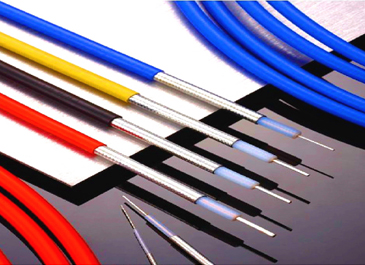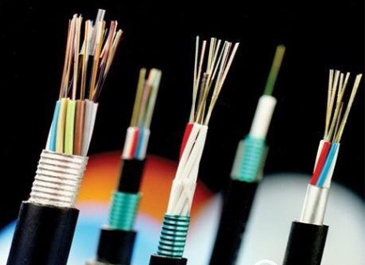Analysis of market status and development prospect of optical fiber and cable industry
Where will China's optical fiber and cable industry go in 2019?
Fiber optic cable line
With the landing of broadband China and Internet plus strategy, especially the continuous construction of fiber to the home and 4G, China's optical fiber and cable market has been booming in the past few years, and the market scale has further expanded, and the strength of the leading enterprises has been increasing. In 2019, one belt, one road initiative, will continue to advance in the face of 5G business. What direction will China's optical fiber and cable industry go to? What technological innovations can not be ignored? Is there any uncertainty in the market?
The output of China's optical fiber and cable industry has exceeded 200 million core kilometers
According to the statistical data of "China's optical fiber and cable industry development prospects and investment forecast analysis report" released by the foresight Industry Research Institute, China's demand for optical fiber and cable accounted for about 57% of the global share in 2017, and China's position as a major optical fiber and cable manufacturer has been established. Since 2011, the output of optical fiber and cable in China has been increasing year by year. In 2011, the output of China's optical fiber and cable industry was only 95 million core kilometers. By 2016, the output growth of China's optical fiber and cable industry has exceeded 200 million core kilometers, with an average annual growth rate of 16.7% from 2011 to 2016. By 2017, the output of China's optical fiber and cable industry has reached 2.09 million core kilometers.
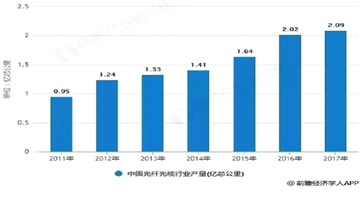
In 2018, China's optical fiber and cable market showed a state of oversupply
In 2018, China's optical fiber and cable market changed from short supply to oversupply. From the perspective of market demand, the continuous construction of fiber to home and 4G has greatly boosted the demand of China's fiber and cable market in the past few years. In 2018, due to the fact that 5g construction has not yet officially started, the construction of FTTH and 4G network scale has been basically completed, and the market demand has declined. At the same time, from the perspective of supply, under good market expectations, optical fiber and cable enterprises have launched new and expansion projects in the past few years, and the production capacity will be released in 2018. Therefore, under the action of multiple factors, there are signs of oversupply in China's optical fiber and cable market.Six factors help the rapid development of the industry in 2019
Industry insiders remain optimistic about the market trend of China's optical fiber and cable industry in 2019 and in the future. In the early stage of 2019, operators' demand for optical network construction may be close to that in 2018. However, with the substantive construction of 5g pilot network and the continuous promotion of China's strategic deployment of "network power", "Digital China", "smart society" and "Rural Revitalization", 5g pilot network has entered the substantive construction stage With the continuous improvement of residents' information consumption level and industrial informatization level, the future development of the industry is positive and optimistic
1. 5g construction is considered to be the most critical factor affecting the future development of optical fiber and cable industry. The industry predicts that the number of 5g base stations will be 4-5 times of 4G base stations, and its high-density networking and high bandwidth will require a lot of optical fiber. In December last year, the Ministry of industry and information technology issued 5g system test frequency licenses to the three major operators, and 5g has entered the system test stage. In 2019, the operators will carry out the construction and deployment of 5g system test base station, so as to ensure the realization of 5g commercial target in 2020.
2. Data center is an important infrastructure for Internet services such as cloud computing and big data, as well as telecommunication network. Massive data traffic will be generated inside and between data centers, which will undoubtedly stimulate the demand for optical fiber and cable, and will continue to grow in the future.
3. Universal telecommunication service is an important foundation for narrowing the digital gap between urban and rural areas, fighting a precise fight against poverty, and building a moderately prosperous society in an all-round way. The support of the national development and Reform Commission and the Ministry of industry and information technology for the new generation of information infrastructure construction project in 2019 will focus on the improvement of the infrastructure of small and medium-sized cities in the central and western regions and northeast regions, which will boost the demand for optical fiber and cable in these regions.
4. Smart city and Internet of things applications will also form new demands. Smart city is not only the application of narrow-band Internet of things technology, but also a large number of video devices need the connection of optical fiber network. At present, the "Xueliang project" promoted nationwide has driven the demand of optical fiber and cable. At the same time, the future oriented new smart city represented by the "digital twin city" will have a global coverage, dynamic and static combination, three-dimensional perception terminal layout. For example, in the planning outline of xiong'an New Area in Hebei Province, the intelligent level of infrastructure ≥ 90% is listed as the construction index requirement. These will eventually drive the growth of demand for optical fiber and cable.
5. With the development of industrial Internet and intelligent manufacturing technology, communication network will further extend and sink to enterprises and manufacturing sites. In the future, it will be possible to directly connect optical fiber network to industrial production areas.
6, one belt, one road initiative has been actively applied to China's fiber optic cable enterprises to increase exports or build production bases overseas. At present, many enterprises have made remarkable achievements in overseas markets.
The pace of multi-point flowering technology innovation is not reduced
The rapid rise of mobile Internet applications represented by video, as well as the popularization of cloud computing, big data, artificial intelligence and other technologies and applications, are putting forward higher requirements for optical transmission network. In this context, in order to meet the needs of massive applications and network evolution, optical fiber and cable technology is also accelerating the pace of innovation and evolution.
In the aspect of long-distance communication trunk line, g.654e optical fiber will be more and more used in the network, and will also develop to the direction of ultra-low loss and C + L band multiplexing in technology; in the field of data center, the optical fiber in the data center is developing to the bandwidth, the optical cable and connector are developing to the high density, and to the on-board connection; In the field of metropolitan area network and access network, G.657 optical fiber will be applied in more occasions, and the optical cable will develop in the direction of light, all media, anti rat and anti ant, high flame retardant, easy branching and connection; in the field of 5g forward transmission, the optical cable suitable for 5g radio frequency remote is the focus of new product research and development, and the optical hybrid cable which is easy to be terminated is the most concerned.
For the cutting-edge optical fiber technology facing the future, the report thinks that multi-core optical fiber, few mode optical fiber, multi-core + few mode optical fiber and photonic orbital angular momentum optical fiber (OAM) are the research hotspots, but from the overall system maturity, these technologies will not be applied in the near future.
On the whole, the R & D of optical fiber and cable in China is evolving in the direction of diversified innovation and shortening innovation cycle. At present, the verification test of new R & D products, especially those designed for 5g scenarios and data center scenarios, is on the increase. The verification test of new products developed for overseas markets and the product quality inspection for product access certification (such as European CPR, ROHS, etc.) for overseas markets are on the increase.
It is worth mentioning that while the innovation of optical fiber and cable technology and products is accelerated, the quality is still a problem that can not be ignored. At present, with the rapid release of optical fiber and cable production capacity, there are signs of oversupply in the industry, resulting in some irrational competition. Liu Tai believes that short-term low price competition is a means of market competition, while long-term low price competition and malicious low price will bring some unhealthy effects to the development of the whole industry. Optical fiber and cable industry is the cornerstone of the network, and its quality directly affects the service running on the network, as well as the security of communication and life and property.
In the market environment of overcapacity and oversupply, on the one hand, manufacturing enterprises should stick to the bottom line of quality and reduce costs through technological innovation; on the other hand, operators should also choose reasonable bidding methods to create a dynamic ecological environment.
Expand advantages and move towards "high quality" development
At present, the characteristics of China's economic development have changed from high-speed growth to high-quality development. In this trend, "high quality" development is also an important goal of China's optical fiber and cable industry.
At present, the scale and development speed of China's optical fiber and cable industry is second to none in the world. From the data point of view, the demand of China's optical fiber and cable industry in recent years has exceeded half of the global demand, which has brought China's optical fiber and cable industry more sufficient growth space. At the same time, the independent innovation ability of China's optical fiber and cable industry has been steadily improved. Breakthroughs have been made in the localization of optical fiber, optical fiber and preform production technology, as well as in the research and development of new products and process improvement, gradually getting rid of the situation of being controlled by others. The product performance and production efficiency have reached the international advanced level, and a number of international leading enterprises have emerged, which have cultivated independent innovation talents And it is further improving in the direction of intelligent manufacturing and green manufacturing.
China's optical fiber and cable industry also has a relatively complete industrial chain and supporting system. In terms of industrial chain, China has the production and mass production capacity of most raw materials and production equipment of optical fiber and cable, which can support the large-scale production of optical fiber and cable in China to a certain extent; In terms of supporting system, China has a perfect system in the standardization, testing and certification of optical fiber and cable. While docking with international standards, it has formed its own system of whole industry chain standard family. At the same time, the third-party laboratory also has the corresponding testing ability, which can effectively support industrial innovation and quality improvement.
However, what we need to see is that although the scale of China's optical cable line construction is relatively large in recent years, the product category is relatively single. Most enterprises focus on improving the production efficiency, capacity improvement and cost control of mainstream products to enhance their competitiveness, and the diversification ability of product line is relatively weak. At the same time, although most of China's optical fiber and cable production enterprises have established a perfect quality system, many upstream raw material production enterprises are still small and medium-sized enterprises which started late. Some enterprises lack quality control awareness and quality control ability, which leads to large differences in raw material supply batches and uneven quality, which brings risks and risks to optical fiber and cable production enterprises Hidden danger.
Facing the future, based on the remarkable achievements made in the past 40 years, China's optical fiber and cable industry needs to further develop and expand its advantages, make up for its shortcomings, have a stronger influence in the global market, cultivate global enterprises with outstanding technological innovation strength, and provide more powerful support for the construction of China's "network power".
Looking around the world, optical fiber and optical fiber rod industry continues to develop well
Since 2005, the global optical fiber and cable market has gradually stepped out of the downturn, especially FTTx technology has been favored by more and more telecom operators, which makes the global optical fiber and cable market demand steadily increase year by year. According to CRU data, in 2017, the global demand for optical fiber and cable reached 492 million core kilometers, with a year-on-year growth of 15.76%.
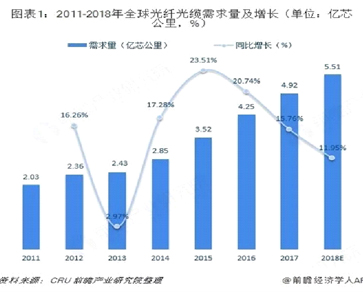
SHAPE * MERGEFORMAT
Driven by the market demand, the global output of optical fiber and cable also shows an increasing trend year by year. Specific data show that from 2010 to 2017, the compound growth rate of global optical fiber output reached 14.42%, with significant growth; in 2017, the global optical fiber output was 534 million core kilometers, with a year-on-year growth of 13.38%.
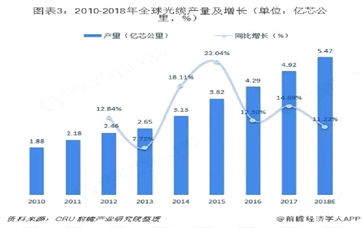
In terms of optical cable, government information construction policies, the formation of consumer information consumption habits, the expansion of operators' market network construction and the development of optical communication technology continue to promote the development of the global optical cable industry. Among them, the United States has launched the construction of domestic optical fiber infrastructure; Germany has issued the "Gigabit Germany" strategy, and plans to invest 100 billion euros in the construction of high-performance national broadband network by 2025; France, Spain and Indonesia have also launched the national information construction; the three major state-owned telecom operators in China are also continuously and vigorously investing in the construction of information network.
In this context, since 2010, the global optical cable production has been increasing. In 2017, the global optical cable output reached 492 million core kilometers, with a year-on-year growth of 14.69%; it is expected that the global optical cable output will reach 5.47 million core kilometers in 2018.
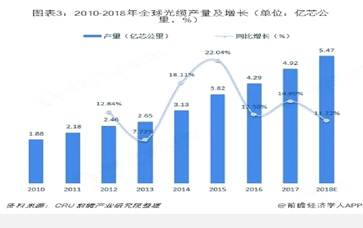
Benefiting from the rapid growth of optical fiber demand, the global optical fiber preform industry is also developing rapidly. At present, the supply of optical fiber preform is in short supply all over the world, which promotes the expansion project of optical fiber preform. According to CRU data, by the end of 2017, the global optical fiber preform production capacity had reached 535 million core kilometers; in terms of production, the global optical fiber preform production was about 16000 tons in 2017.
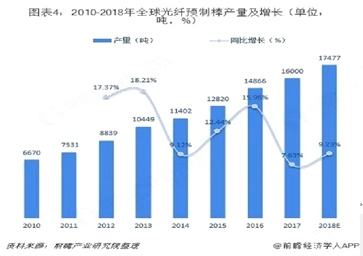
From a regional perspective, by the end of 2017, China has become the largest optical fiber and cable manufacturer in the world. According to incomplete statistics, in 2017, China's optical fiber and cable rod production capacity ranked first in the world, accounting for nearly 50% of the world, reaching 49.44%; while Japan and the United States accounted for 19.18% and 16.76% respectively; EU's production capacity in the field of optical fiber and cable rod gradually increased, accounting for 7.2% of the world. While China's production capacity continues to grow, Japan and the United States have serious overcapacity, the European Union and other countries have gradually increased their production capacity (actively laying out optical fiber networks), and China, Japan and the United States still account for about 85% of the overall market share.
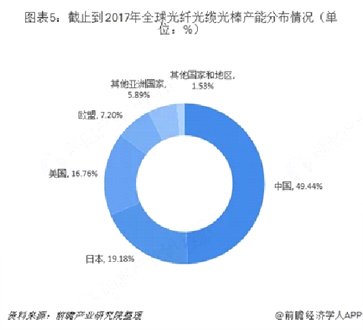
SHAPE * MERGEFORMAT
Global optical fiber and optical fiber rod industry still has a bright futureAffected by the continuous policy support from governments, the rapid growth of mobile Internet, the implementation and application of 5g technology, and fiber to home, the global fiber optic cable industry will continue to maintain steady growth, the market demand for fiber optic cables will further increase, and the industry will usher in a new round of development opportunities.
For example, the number of base stations needed for 5g network coverage is about 1.5-2 times that of 4G era, with a total of 9 million base stations. In the forward link, 50% of the scenarios will adopt the optical fiber direct connection scheme, which consumes a lot of optical fiber and cable; in the intermediate and return links, OTN technology will be used for networking, resulting in the demand of optical fiber and cable similar to the current man. It can be seen that with the acceleration of 5g construction process, it will drive more demand for optical fiber and cable. It is estimated that by 2023, the global supply of optical fiber and cable will reach 1.182 billion core kilometers, and the demand will reach 1.073 billion core kilometers, with broad development prospects.
In terms of optical rods, with the continuous improvement of China's technical strength in the field of optical fiber preform, more and more enterprises will participate in the production of optical rods, and the improvement of optical rod production capacity is only a matter of time. Driven by the substantial increase in China's production capacity of light rods, the global production of light rods will gradually increase. The improvement of the demand for optical fiber and cable will also drive the stable improvement of the demand for optical rods. The Institute of foresight industry predicts that by 2023, the global output of light wands will reach 36500 tons; the global demand for light wands will also reach 36300 tons, and the problem of overcapacity may be aggravated with the passage of time.
(source: prospective industry research institute)






